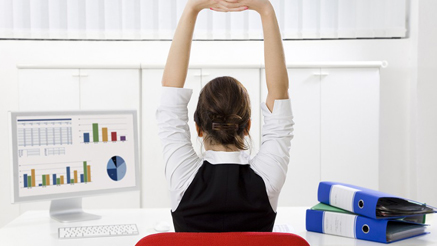Millions of us have jobs that require us to sit at desks or around conference tables for several hours per day. Many health risks are associated with sitting down for prolonged periods — but how do we stay active in the workplace?
Research has demonstrated that sitting for an extended period is linked with obesity, type 2 diabetes, and an increased risk of death from heart disease and cancer. Excessive sitting may also slow metabolism, which has an impact on the body's ability to regulate blood pressure and blood sugar, as well as break down body fat. Injecting physical activity into your working day could reduce some of the health risks that are elevated by being sedentary.
1. Cycle or walk to work
Depending on the location of your job and how far you work from home, try switching up how you get to and from work. Leave the car at home and cycle or walk instead.
When compared with commuting to work by car or public transport, cycling to work has been linked with a reduced risk of death from all causes, and a lower cancer risk. Furthermore, people who walk or cycle to work have a lower body mass index (BMI) and body fat percentage in midlife than those who commute by car.
Those who actively commute to work, by foot or by bike, also benefit from improved well-being and report feeling more able to concentrate and under less strain than those who travel to work by car.
2. Stand up regularly
Something as simple as standing up now and then while at work could help curb the related health risks of sitting for too long.
According to a study by British Journal of Sports Medicine in 2015, it was concluded that office workers should stand up for at least 2 hours during their work day, with that target eventually reaching 4 hours, to break up prolonged sitting. Researchers believe that incorporating standing and walking behaviors into the work day might be more doable for workers than targeted exercise.
Recommended work-based standing behaviors include:
- standing or light activity for 2–4 hours during work hours for workers who are mostly desk-based
- using sit-stand desks or standing workstations to break up sitting-based work regularly
- avoiding prolonged static standing, which can be just as harmful as sitting for too long
- altering posture frequently to prevent potential musculoskeletal pain and fatigue
The findings showed that standing burned 0.15 calories per minute more than sitting — which, over the long-term, would equate to a 143.3-pound adult losing 5.5 pounds in 1 year and 22 pounds in 4 years, providing they did not increase their food intake. Using standing desks has also been shown to have neurocognitive benefits.
3. Move more
Moving more may sound like an obvious action to take when trying to be less sedentary, but, when in the depths of a taxing project, it's easy for many hours to fly by without any sign of movement.
Research has found that for every extra hour of sitting over 5 hours, waist size increased by 2 centimeters and the risk of cardiovascular disease by 0.2 percent.
A study led by the University of Leeds in the United Kingdom suggested that small movements — such as those involved in fidgeting — might counteract some of the adverse effects of prolonged sitting.
Some of the few changes which can be made in your day to life include:
- Walk to a co-workers desk to speak with them instead of sending an email.
- Take the stairs instead of the elevator.
- Park your car a few blocks away from your work entrance.
- Take the "scenic" route to your desk to fit in some extra steps.
- Reorganize your desk so that you have to stand up and reach for any tools you regularly use.
- Stand up to answer the phone or write emails.
- Set an alarm to remind you to take a quick activity break.
4. Re-engineer the work environment
Incorporating physical activity into your working day has numerous health benefits, decreases work absence, and boosts cognitive abilities, mood, and productivity. Given all the positive outcomes of being less sedentary, your boss may be open to changing up the working environment to provide more options for movement.
Some firms are already offering stretch classes before work, yoga breaks during office hours, and lunchtime running groups to help workers to look after their well-being and increase work efficiency.
Some of the steps which can be taken to re-engineer the office environment include:
- Removing chairs and desk seating.
- Encouraging walking meetings.
- Creating walking tracks
- Introducing a pedometer program
- Using mobile sets instead of traditional phones
- Introducing games to the workplace
- Offering activity monitors
- Advising employees on activity and nutrition
- Adding desks with movement interventions, such as treadmills
- Sitting on bounce balls.
5. Take an active lunch break
Rather than eating your lunch at your computer while checking your smartphone and answering emails, take a break and do something physically active. You will go back to work feeling refreshed, revived, and more able to concentrate for the rest of the day.
Taking an active lunch break could help you go back to work refreshed and motivated. Whether you go for a brisk walk, cycle, swim, or to your gym for an hour, doing exercise of any kind helps to break up your day and motivate you for your remaining hours in the office.
Courtesy: MedicalNewsToday

